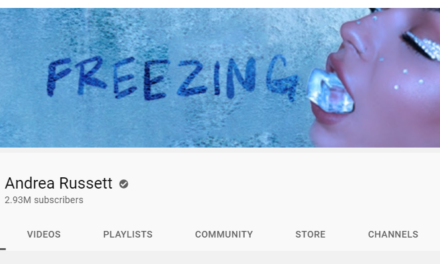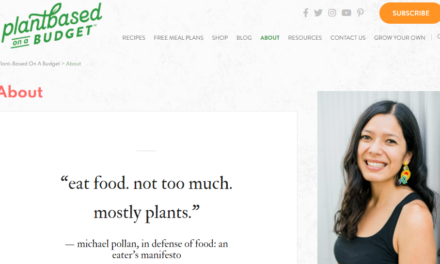The creator economy spurs a lot of research. Unfortunately, too much of it just scratches the surface. They talk about what grabs the headlines – 303 million creators, $100 billion-plus industry, etc. Or they focus on the high-profile, big-bucks influencer category of the industry.
The Tilt opts to go beyond those popular headlines. We gather data from content creators to truly understand the successful journey of a content entrepreneur. Their answers reveal what it takes to build a successful content business, and that’s our goal – to help you become a successful content entrepreneur.
In The Tilt’s 2023 Content Entrepreneur Benchmark Research, you will learn about content creators’ tactics, timelines, audience metrics, revenue, income, and more. This year’s survey encompassed 1,043 creators and 397 individuals who want to be creators.
Key findings in our creator economy research
- Succeeding without a massive audience: Creators have 4,000 followers on average, and they use just four channels to reach their audience (and just two channels to monetize).
- Walking an 18-month financial runway: Creators say it takes five months to earn the first dollar, 13 months to go full-time, and 18 months to fully support themselves.
- Doing it for more than money: Content creators are in search of enjoyment, independence, and flexibility before all else. In other words, quality of life beats everything else.
That just scratches the surface. Read on to find out more details – from early launch decisions to scaling ventures. You have a question? We have a stat for it.
Forget the influencers and makers. The 2023 Content Entrepreneur Benchmark Research is all about creators building content businesses around their expertise. #CreatorEconomy Share on XThe creator economy is huge; we studied one critical segment
Many people call themselves creators – from artists who sell their wares on Etsy to musicians with loyal followings on Bandcamp. But The Tilt focuses on a slice of the creator economy: People who produce and monetize content.
So let’s answer that all-important question: Who did The Tilt study in this survey? Perhaps it’s best to start with who they are not:
- Maker creators: People who create content about their craft or hobby. They may monetize the content, but they also sell things. Think artists, craftspeople, chefs, homesteaders, etc. The list is nearly endless. We don’t focus on maker creators because makers run a very different type of business. They have raw materials and inventory and ship physical goods.
- Influencers: People who operate personality-driven businesses that publish content to monetize their popularity and celebrity. We don’t focus on influencers because they thrive on popularity, not skill or knowledge. Plus, the business can’t be easily sold since it’s tied to one person.
Now that we have that out of the way, who are the people we are laser-focused on helping? Expert creators.
Expert creators are people who create content about their area of expertise or passion. Expert creators build media companies (even small ones) and monetize their content. Some expert creators also sell a service (e.g., coaching, consulting, educating).
Vision for their content business model
Of those surveyed, 13% create content as a side gig and aren’t interested in the complexities of running a larger business. Eleven percent are in it to scale into a big venture with employees and diversified revenue streams. Most, however, settle in between those goals. Thirty-eight percent say they plan to be a solopreneur without employees or contractors. Thirty-six percent plan to grow a small business that supports themselves and a few employees or contractors.
Though we surveyed all content creators, the study centers on the people who devote most of their working time to their content business – the all-in creators.
Anatomy of a content entrepreneur
Let’s dig into the numbers for each step of the content entrepreneur’s journey, from early audience development to monetization and scaling the business.
Audience
Most creators have relatively small audiences. People who run their content business as a full-time endeavor have an average of just 4K followers across all channels. For most, it’s not the size of the audience but how deeply engaged they are with the content.
Content creators operate full-time businesses with an average of just 4K followers across all channels via new #CreatorEconomy survey: 2023 Content Entrepreneur Benchmark Research. Share on XChannels
All-in creators (people who spend most/all their work time on the content business) use just four channels on average for their content business, and of those, two bring in direct revenue. Not surprisingly: Social media content is the most common type of content creators publish to reach their audience; blogging and email come in at No. 2 and No. 3.

Channel trends
Among these content creators, YouTube, TikTok, and LinkedIn are all rising in popularity. The use of YouTube Shorts and TikTok has surged in the last two years. Similarly, LinkedIn traffic has grown over the last three years, with a strong uptick in usage in the last quarter due to layoffs.
IMAGE
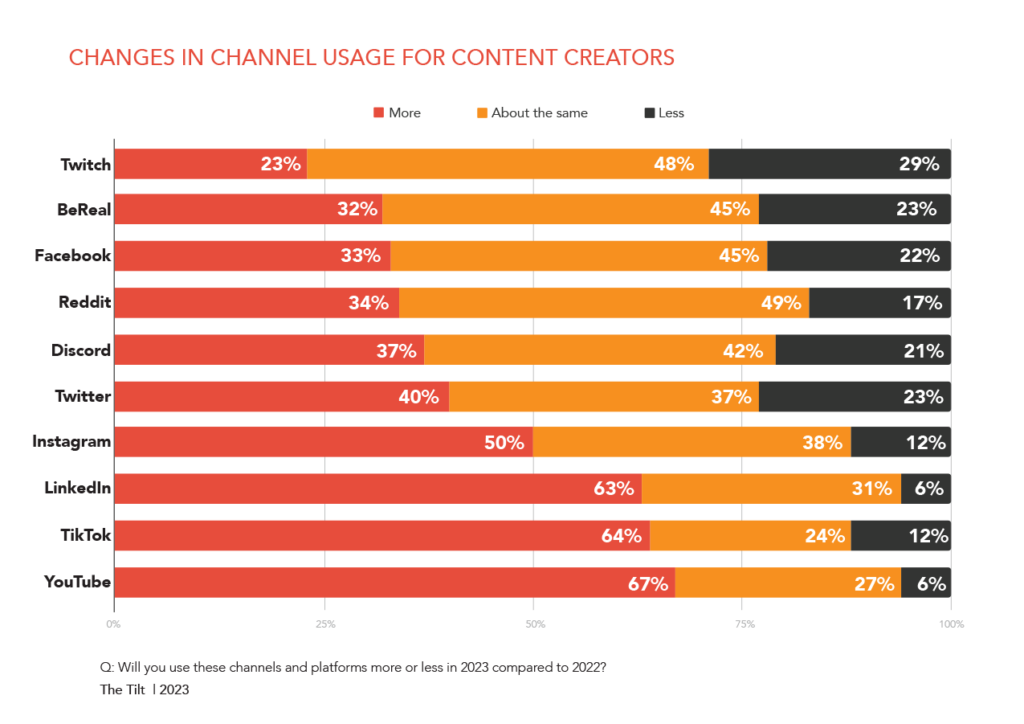
Content monetization
These content entrepreneurs most likely use consulting/coaching, book publishing, and online classes to make money, and they report those three are the most profitable. Note that “paid memberships and communities” ranks eighth in use but fifth in most profitable – an interesting nod to that type of monetization.
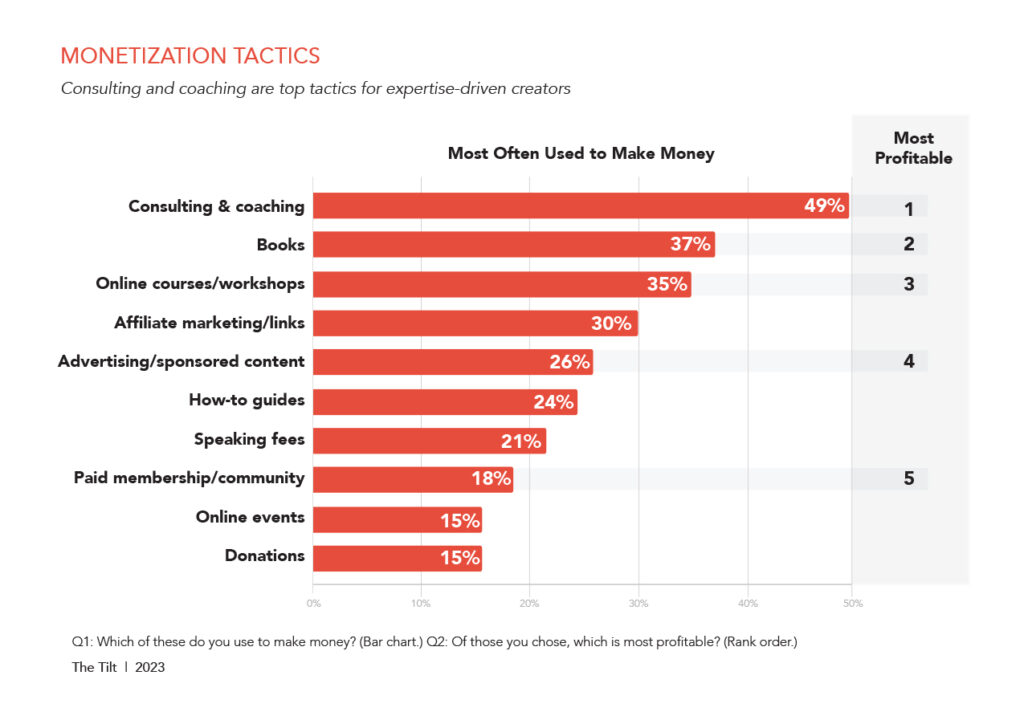
Barriers
Taking the leap is a big step for any entrepreneur, and not surprisingly, financial fears top the list of reasons why would-be content creators haven’t made a go of it. Forty-five percent say they don’t know where to begin, while 41% don’t have the time to do it well. With 31% of would-be content entrepreneurs not feeling qualified and 28% saying financial insecurity holds them back.

Runway
At The Tilt, we dedicate a lot of time talking about runway – the time between launching a creator business and supporting the creator’s personal financial needs. The shorter the runway, the more likely someone is to succeed as a content entrepreneur.
All-in creators say it takes nearly five months to earn the first dollar and just over a year to begin working full time as a creator. Someone who works full time in their content business is not necessarily supporting themselves; that takes over 18 months. And hiring people to help with the business also takes roughly 18 months.
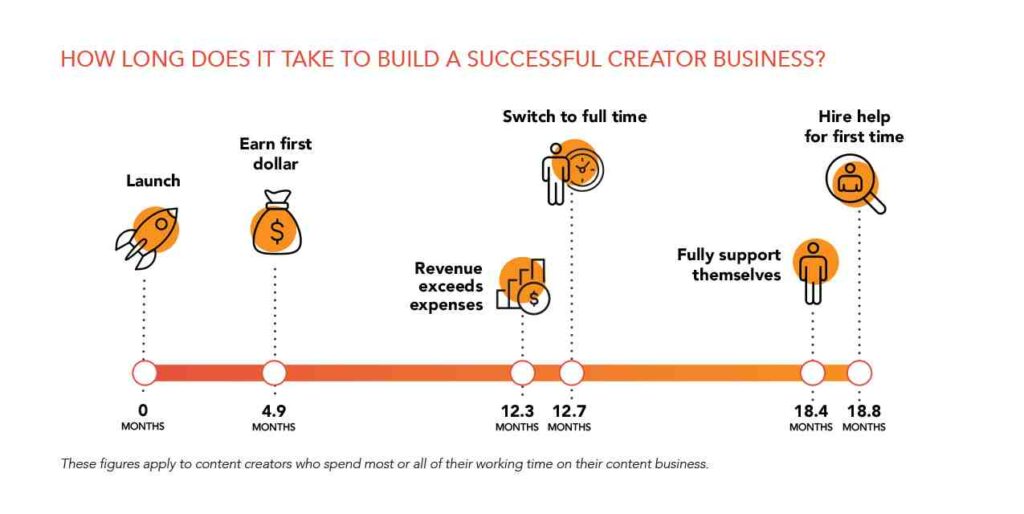
Seed capital and technology budget
Content creators spend $10.7K on average to start their business, and well over half (66%) rely on savings to fund their new business. Technology expenses alone cost $2K per year (though in the first three years, technology expenses tend to run about half that).

How much do creators make?
Creators who spend most/all of their working time on the content business report they earned approximately $86K in 2022 — a figure highly dependent on how long they’ve been in business.
Let’s unpack the numbers a bit more. We asked content creators to tell us what they expect to gross in 2023 (i.e., revenue before expenses and salary), expected profit, and the amount they say would be “enough.”
The all-in creators say they’ll bring in approximately $108,199 in revenue in 2023 and will pay themselves $62,224 — a gross margin of 59%. The $62K figure is a little more than half of what they would like to earn ($109,250) from the content business.
Full-time content entrepreneurs expect to earn an average $108,199 in revenue and take home $62,224 in 2023 via #CreatorEconomy research from @TheTiltNews. Share on XHow do creators spend their time?
All-in creators work 36.5 hours per week on average – slightly less than a traditional full-time job. But they’d like to work fewer hours (about 28.5 hours a week). Content creation takes a little less than half of their time while running the business consumes the remainder (an important reminder to people who believe being a creator is all about the creative).
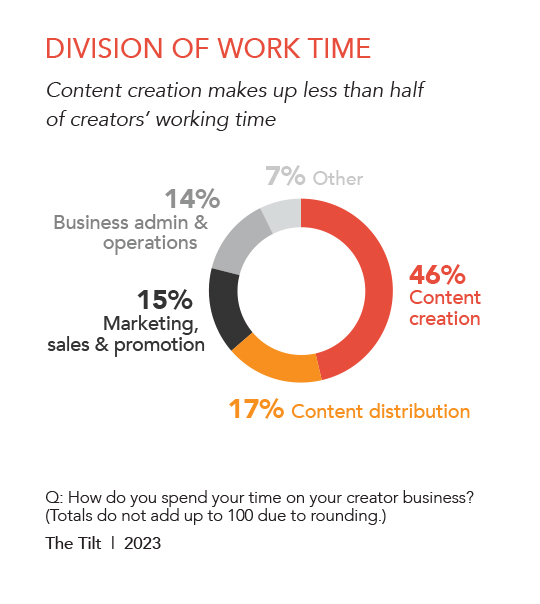
Successful creators are entrepreneurs – not just in name but in dogged day-to-day drive to build, grow, and sustain their businesses. Indeed, 95% say business skills are just as important as creative skills, and 86% think of themselves as entrepreneurs. We believe content creators need to embrace the skills and mindset of entrepreneurs, whether they’re building a smaller hobby business or have plans to build a large enterprise.
Want to learn more about the content creator journey? Download The Tilt’s 2023 Content Entrepreneur Benchmark Research (no registration required).
Contemplating or already traveling the content entrepreneur’s journey? Subscribe to The Tilt’s twice-weekly newsletter with practical advice on operating your business, stories of what your peers are doing, and news that impact you.
About the author
Joe Pulizzi is founder of multiple startups including content creator education site, The Tilt and is the bestselling author of seven books including Content Inc. and Epic Content Marketing, which was named a “Must-Read Business Book” by Fortune Magazine. Joe is best known for his work in content marketing, first using the term in 2001, then launching Content Marketing Institute and the Content Marketing World event. He has two weekly podcasts, the motivational Content Inc. podcast and the content news and analysis show This Old Marketing with Robert Rose. His foundation, The Orange Effect, delivers speech therapy and technology services to over 200 children in 34 states.

![How Creators Build an Expert-Based Content Business [Creator Economy Research]](https://www.thetilt.com/wp-content/uploads/2023/04/creator-economy-research-2023-feature.jpg)
